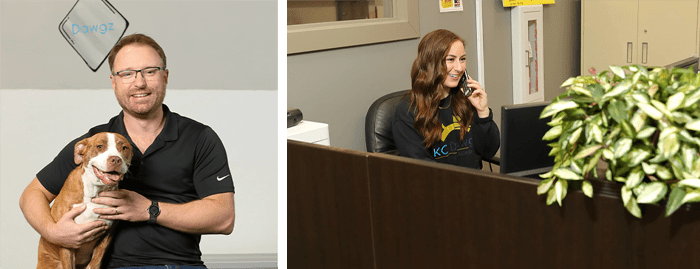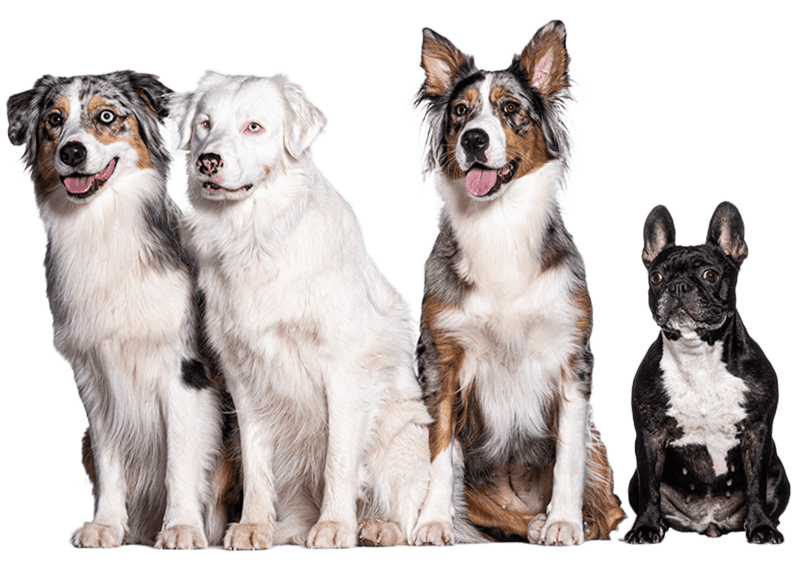KC Dawgz’s training program is proprietary and unique in its development. We carefully assess each dog’s learning style and ease them into our philosophy so that the dog can experience training in a safe, happy, healthy environment. Each piece of our training philosophy is cultivated to address the dog’s needs and instincts and tap into those centers in order to facilitate a positive dog training atmosphere.


The first phase of learning where the dog acquires knowledge of a particular behavior.
The second phase of learning where the dog essentially becomes “fluent” in the new behavior. In this phase it is as if the behavior becomes a fluid response – behaviors become rhythmic and automatic.
In this third phase of learning, the dog learns that behaviors are relevant in a wide variety of situations.
The dog learns to incorporate behavior into its permanent behavior vocabulary in this fourth and final stage of learning.
Operant conditioning is a conscious form of learning where a dog learns that his actions have positive or negative consequences. Sometimes referred to as “instrumental learning”, Operant conditioning contains four quadrants of active learning: positive reinforcement, negative reinforcement, positive punishment, and negative punishment. It’s important to understand that positive and negative in this case does not mean “good” or “bad”. It simply means something is added or taken away. We believe that teaching your dog what to do, but also what not to do is critical for dogs to have the most success. By utilizing all four quadrants of operant conditioning, we teach our dogs to think critically and react in an appropriate manner.
Operants become stronger through conditioning. This is identical to the way that you condition a muscle with physical conditioning. Scientifically speaking, when you are conditioning an operant, you are making it stronger by raising the likelihood or probability of it being repeated through reinforcement.
Training is something we do to increase the probability of a behavior being repeated. It doesn’t simply implant knowledge into the dog. A dog’s behavior is controlled by the consequences experienced as a result of a particular behavior. Because of this, in training it is necessary to deliberately manipulate various consequences so that we can control and mold the dog’s behavior.
Also known as “Pavlovian conditioning” and “associative learning”, classical conditioning is an unconscious form of learning that is all about anticipation. Something that previously had no importance to the dog is paired with something of great importance. When learning associations, the dog learns that certain things go together; when one event happens, another event will follow shortly after. When we pair two particular events, we are creating a predictable relationship and the dog learns to respond to the first event by anticipating the event that will follow. When we pair something that your dog likes (food or their favorite toy) with a word or sound, he learns to associate the two and look forward to that sound.
At KC Dawgz, we follow a humane hierarchy which outlines the hierarchy for behavior changes in dogs. This hierarchy begins with physical health and nutrition as the most positive and least intrusive way to approach behavioral changes. See the pyramid below for the full hierarchy.
One of the first and most important steps to seeing success in your dog is making sure you are adequately fulfilling them physically, mentally, and nutritionally. This, in conjunction with training leads you to the desired results.
KC Dawgz uses positive reinforcement, meaning that when the dog does something good, we give them a reward. We do this so they will keep doing good things in the future. We also use something called variable reinforcement, which means we don’t give rewards every time the dog does something right, but just enough that the dog keeps hoping for a reward.
At KC Dawgz, we use differential reinforcement as our chosen method of behavior modification training. Differential reinforcement is a way to use rewards to increase good behavior and remove triggers that lead to bad behavior. We provide rewards for good behavior and take away triggers for bad behavior. This helps the dog learn better ways of behaving instead of the bad ones.
There are four ways to help stop disruptive behaviors. They are called differential reinforcement of incompatible behavior (DRI), differential reinforcement of alternative behavior (DRA), differential reinforcement of other behavior (DRO), and differential reinforcement of low rates of responding (DRL).
With DRI, you give someone a reward when they do something that won’t let them do the bad behavior. For example, if someone can’t pay attention, then giving them a reward for paying attention would be an incompatible behavior.
DRA is like DRI in that it rewards different behaviors instead of the ones you want to reduce. For example, a dog who barks too much for attention can be taught to sit nicely instead. With DRA, the dog can do both things at the same time – bark and sit nicely. But if we reward sitting nicely more, then it’s likely that the dog will bark less and just sit nicely when they want attention. When using DRI and DRA, it is important to choose an existing behavior or response that the dog already knows. This makes it easier for the dog to learn new skills. After the program is over, they can use these skills in their regular home environment.
DRO is a way to reward good behaviors. If someone does something wrong or bad, they don’t get the reward. The reward only comes after a certain amount of time if the person doesn’t do anything wrong. If the person does do something bad, then they don’t get the reward and have to wait another set amount of time to try and get it again by doing something good. DRO can use either fixed or variable schedules. Fixed means the same amount of time is used each time. For example, reinforcement might be given every one minute if there is no bad behavior. Variable means different amounts of time are used each time. For example, the times could be 15, 30, 45, 60 and 90 seconds in a random order.
Finally, DRL is a way to help reduce a behavior that happens too often or for too long. We set up a rule, like the dog can only bark 5 times in 20 minutes. If the dog follows that rule, they are rewarded. If not, they don’t get the reward. Getting a well rounded, balanced dog requires balanced training.
Positive punishment is another quadrant of operant conditioning. We use positive punishment to teach our dogs what not to do in a certain situation. Before we introduce positive punishment into training we have to make sure that your dog understands what the proper expectations are and what to do instead of the undesired behavior. This is added in training with continued positive reinforcement when the dog does the desired behavior instead of the undesired behavior. By showing our dogs what not to do it allows us to reward them more often when they complete the desired behavior.
Barking: The Sound of a Language by Turid Rugaas
Help! My Dog has an Attitude by Gwen Bohnenkamp
On Talking Terms With Dogs: Calming Signals by Turid Rugaas
The Other End of the Leash: Why We Do What We Do Around Dogs by Patricia McConnell
Excel-erated Learning: Explaining in plain English how dogs learn and how best to teach them by Pamela J. Reid
Grit: The Power of Passion and Perseverance Young Readers Edition by Angela Duckworth
Behave by Dr. Robert M. Sapolsky
The Talent Code: Greatness Isn’t Born. It’s Grown. Here’s How. by Daniel Coyle
Animals in Translation: Using the Mysteries of Autism to Decode Animal Behavior (Scribner Classics) by Temple Grandin and Catherine Johnson
Grit: The Power of Passion and Perseverance by Angela Duckworth

WEB SERVICES BY KCWEBDESIGNER.COM | KCSEOPRO.COM